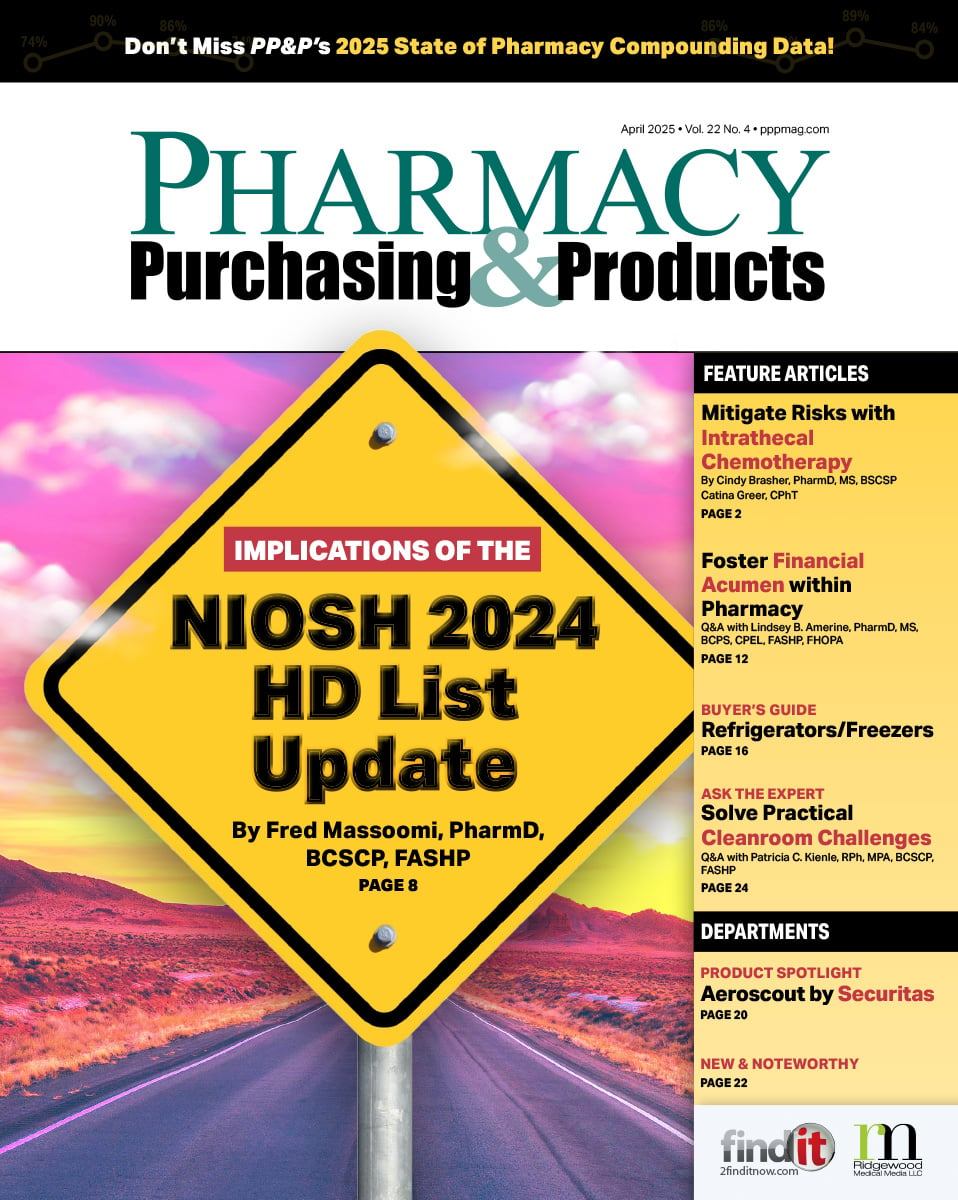- Show Menu
- Contact Us
- FAQs
- Reader Service
- Survey Data
- Survey Winners
- Testimonials
- Upcoming Events
- Webinars
- White Papers
Evolving Roles for Pharmacy Technicians

Pharmacy technicians play an integral role in all hospital pharmacy medication delivery models. According to the US Bureau of Labor and Statistics, there were 420,400 pharmacy technicians in the workforce in 2018. Their job outlook includes a forecasted 7% growth over the next 10 years, which is faster than the average projected growth rate for all professions, 5%, during the same period.1 Conversely, there are currently 314,300 pharmacists in the workforce and the growth projection for pharmacists over the next 10 years is 0%, well below the 5% national average. The continued growth of the pharmacy technician profession may even outpace estimates, considering the increase in pharmacist involvement in non-traditional roles, as well as the potential for pharmacist provider status, both of which would shift pharmacist resources away from operational responsibilities and into roles more akin to mid-level clinical providers.
Considering the evolving responsibilities of pharmacists, as well as the increase in reliance on automation and technology, technicians must adopt new roles to satisfy the current and future needs of pharmacy practice. Pharmacy technicians can undertake operational roles, including medication distribution, use of technology and automation, project management, quality improvement, supervisory roles, as well as certain clinical roles.2 The profession of pharmacy must plan accordingly to meet the future needs of our patients; this includes establishing standard job descriptions for next generation technician roles, developing new and innovative training programs for pharmacy technicians, as well as breaking down barriers to advancing and promoting them.
Technician Roles in Pharmacy Practice
A recent review article described both typical and innovative roles technicians play in medication delivery systems. This study found that although the majority of pharmacy technicians are limited to roles that do not require professional judgement, technicians typically serve as crucial team members who work alongside pharmacists to maximize the pharmacist’s scope and efficiency.3 The term advanced pharmacy technician is not well defined in the industry, but is often used to distinguish technicians adopting new and innovative roles from traditional technician practice.3
Some common roles for advanced pharmacy technicians include administrative functions, managing patient appointments, administering patient self-reporting tools, billing and documentation, and obtaining medication histories.3,4 Some of the most common and emerging roles follow.
Acute Care Roles
Technicians have long been staples of acute care pharmacy operations and are integral to medication distribution functions in the inpatient setting. As technology and training have evolved, technicians have taken a more significant leadership role in inpatient pharmacy operations. Technicians have also assumed additional clinical roles, such as obtaining medication histories for patients in the ED and acute care units.
One unique role includes the expansion of validation technicians, also called tech-check-tech. Additionally, with widespread nursing shortages across the country, utilizing ADC technology and pharmacy technicians at the medication pass, as well as in medication administration roles, have also been piloted at various institutions.3,5
Ambulatory Roles
As health care transitions to a value-based care model, pharmacy can expect a continual push toward care centered around keeping patients out of the hospital, while focusing on specific quality metrics. As health care shifts toward this new standard, pharmacy departments must adapt by developing robust ambulatory care practice models. Utilizing pharmacy technicians in these new models will be crucial. Progressive practice models use technicians, rather than pharmacists, to complete prior authorizations and medication assistance for patients. Due to their medication knowledge, technicians can take on this responsibility more effectively than other staff members. Reassigning these tasks helps decrease patient turnaround time and improves patient education and stewardship of their medications.3
Pharmacy technicians are also utilized in clinical roles in the outpatient setting to follow up with patients on certain quality metrics, such as adherence, vaccination status, and other disease state-specific surrogate outcomes. Technicians can identify and target patients who could benefit from pharmacist intervention, which will be crucial to future efforts aimed at improving the efficiency of ambulatory care.3
Technology and Automation
As health systems continue to maximize technology and automation, including incorporating ADCs and carousels with inventory management software, there is less reliance on human capital to transfer medications and more reliance on technology. Developing positions wherein pharmacy technicians own and manage these technologies is an important way to optimize costly technology, and is an excellent utilization of staff labor.
In addition, at some institutions pharmacy technicians are becoming skilled in informatics and other information technology-related fields. Current literature suggests technicians can effectively manage dispensing technology, which helps decrease the health system’s labor costs.6,7
Purchasing and Finance
Technicians have increasingly been utilized in finance and inventory-focused roles. With proper training, pharmacy technicians have an ideal skill set to help manage inventory and to practice strong purchasing habits that can benefit health systems. With the continued emergence of technology, the prevalence of medication shortages, and the increasingly complex financial structure of purchasing pharmaceuticals, seasoned technicians can serve as important resources to manage this complex environment.2,3
Compliance and Auditing
Pharmacy technicians can help ensure regulatory compliance by assisting in auditing. This role typically does not require the professional judgement of a pharmacist, but rather utilizes specific criteria to audit and evaluate services to ensure they meet quality metrics. Areas where auditing or compliance technicians can provide benefit include controlled substance diversion monitoring, 340B and/or financial compliance, adverse event surveillance, sterile compounding, and discharge medication accuracy.2,3
Supervisory Functions
While there is little discussion in the literature regarding pharmacy technicians adopting supervisory roles, there appears to be an increased uptick of pharmacy technicians in this area. Working alongside pharmacy leaders in administrative areas such as schedule development, human resources, and operations and workflow assessments, technicians are prime candidates to take on leadership roles.
Technician supervisory roles can include project management, staff management, and quality improvement. Advanced technician training and other education, such as obtaining a Master’s degree (Master’s of Business Administration, Master’s of Health Care Administration, or other), should be considered for technicians aspiring to these roles.3 See the SIDEBAR8-11 for more information about training and development for pharmacy technicians.
Barriers to Advanced Roles
Certain barriers must be overcome in order to elevate the roles of pharmacy technicians. Technician salaries, training, universal educational standards, and the perception of technicians in the workplace must be considered.
Compensation
Low compensation for pharmacy technicians is the most significant barrier to entry for highly qualified candidates. According to the US Bureau of Labor Statistics, 2019 pharmacy technician salaries averaged $31,750 annually, which is the lowest compensation among similar professions, including dental assistants, emergency medical technicians, veterinary technicians, and physical therapy assistants. Pharmacy technician wages have also remained relatively flat since 2008, despite the emergence of new and innovative career opportunities.10,12
There are few validated methods in the literature to improve pharmacy technician compensation. The development of pharmacy technician career ladders is a common tactic used to justify to senior leadership the increased skills required for more advanced roles.
Access to Training
Accessing appropriate training can be a significant financial burden for pharmacy technician candidates. In the most recent ASHP Foundation 2020 Pharmacy Forecast, 42% of panelists said that it was somewhat unlikely that at least half of health systems would partner with an accredited pharmacy technician education program. More robust compensation models from employers and health systems will be needed to help technicians access training programs.13
Universal Educational Standards
There are currently no universal education standards required to practice as a pharmacy technician; the most basic requirement across the industry is a high school diploma. Developing universal educational standards can help increase the retention rate of pharmacy technicians.
Perception
Health care organizations continue to struggle with the perception of the career of a pharmacy technician as one with limited opportunities. By developing a structure for new and innovative roles, and ensuring appropriate compensation, pharmacy technicians will be able to visualize a career path with more mobility.
It is crucial that pharmacists embrace the changing landscape of advanced roles for pharmacy technicians. Addressing the compensation and training issues, coupled with continued support from professional organizations, can help overcome these barriers.
Conclusion
Pharmacists will continue to rely on pharmacy technicians to meet evolving health care needs, and to fill the void left behind by pharmacists moving to advanced clinical roles. Unfortunately, the current marketplace does not yet adequately support the training needed to meet the demands in the technician marketplace. Being aware of the current barriers and partnering with our national and state pharmacy organizations will be crucial to move the needle to prepare pharmacy technicians for the future innovative roles that are needed.
References
- US Bureau of Labor Statistics. Occupational Outlook Handbook: Pharmacy Technicians. US Bureau of Labor Statistics. www.bls.gov/ooh/healthcare/pharmacy-technicians.htm. Accessed December 26, 2019.
- Schneider PJ, Pedersen CA, Ganio MC, et al. ASHP national survey of pharmacy practice in hospital settings: Workforce—2018. Am J Health Syst Pharm. 2019;76(15):1127-41.
- Mattingly AN, Mattingly TJ II. Advancing the role of the pharmacy technician: a systematic review. J Am Pharm Assoc. 2018;58(1):94-108.
- Boughen M, Sutton J, Fenn T, et al. Defining the role of the pharmacy technician and identifying their future role in medicines optimisation. Pharmacy. 2017;5(3):40.
- Reed M, Thomley S, Ludwig B, et al. Experience with a “tech-check-tech” program in an academic medical center. Am J Health Syst Pharm. 2011;68(19):1820-3.
- McCarthy BC Jr, Ferker M. Implementation and optimization of automated dispensing cabinet technology. Am J Health Syst Pharm. 2016;73(19):1531-6.
- Seston EM, Ashcroft DM, Lamerton E, et al. Evaluating the implementation and impact of a pharmacy technician-supported medicines administration service designed to reduce omitted doses in hospitals: a qualitative study. BMC Health Serv Res. 2019;19(1):325.
- Mattingly AN. Entry-level practice requirements of pharmacy technicians across the United States: A review. Am J Health Syst Pharm. 2018;75(14):1057-1063.
- Pharmacy Technician Certification Board. PTCB Developing Advanced CPhT Credential. Pharmacy Technician Certification Board (PTCB). www.ptcb.org/news/ptcb-developing-advanced-cpht-credential. Accessed January 7, 2019.
- Wheeler JS, Gray JA, Gentry CK, et al. Advancing pharmacy technician training and practice models in the United States: Historical perspectives, workforce development needs, and future opportunities. Res Social Adm Pharm. 2019.
- North Carolina Board of Pharmacy. North Carolina Administrative Code. www.ncbop.org/LawsRules/Rules.pdf. Accessed October 26, 2019.
- Urick BY, Mattingly TJ II, Mattingly AN. Relationship between regulatory barriers to entry and pharmacy technician wages. Res Social Adm Pharm. 2020;16(2)190-194.
- Vermeulen LC, Swarthout MD, Alexander GC, et al. ASHP Foundation Pharmacy Forecast 2020: Strategic Planning Advice for Pharmacy Departments in Hospitals and Health Systems. Am J Health Syst Phar. 2020;77(2):84-112.
 Nicholas P. Gazda, PharmD, MS, BCPS, CSP, is the assistant director of specialty pharmacy at Cone Health in Greensboro, North Carolina. He oversees and maintains URAC/ACHC accredited specialty pharmacy operations at Cone Health, including the specialty pharmacy call center, mail-order program, and medication assistance program, as well as the embedded ambulatory clinical pharmacists. Nick completed his BS and PharmD at the University of North Carolina at Chapel Hill Eshelman School of Pharmacy. He completed a 2-year PGY1/PGY2/MS health-system pharmacy administration residency at Cone Health and an MS in pharmacy administration in conjunction with the UNC Eshelman School of Pharmacy
Nicholas P. Gazda, PharmD, MS, BCPS, CSP, is the assistant director of specialty pharmacy at Cone Health in Greensboro, North Carolina. He oversees and maintains URAC/ACHC accredited specialty pharmacy operations at Cone Health, including the specialty pharmacy call center, mail-order program, and medication assistance program, as well as the embedded ambulatory clinical pharmacists. Nick completed his BS and PharmD at the University of North Carolina at Chapel Hill Eshelman School of Pharmacy. He completed a 2-year PGY1/PGY2/MS health-system pharmacy administration residency at Cone Health and an MS in pharmacy administration in conjunction with the UNC Eshelman School of Pharmacy
 Tyler A. Vest, PharmD, MS, BCPS, is a pharmacy manager of automated dispensing cabinetry and controlled substances at Duke University Hospital in Durham, North Carolina, and assistant professor of clinical education at the UNC Eshelman School of Pharmacy in Chapel Hill. He completed his health-system pharmacy administration residency at the University of North Carolina (UNC) Medical Center and received his Master’s Degree from the UNC Eshelman School of Pharmacy. Tyler earned his Doctor of Pharmacy Degree from the University of Cincinnati James L. Winkle College of Pharmacy.
Tyler A. Vest, PharmD, MS, BCPS, is a pharmacy manager of automated dispensing cabinetry and controlled substances at Duke University Hospital in Durham, North Carolina, and assistant professor of clinical education at the UNC Eshelman School of Pharmacy in Chapel Hill. He completed his health-system pharmacy administration residency at the University of North Carolina (UNC) Medical Center and received his Master’s Degree from the UNC Eshelman School of Pharmacy. Tyler earned his Doctor of Pharmacy Degree from the University of Cincinnati James L. Winkle College of Pharmacy.
SIDEBAR
Training and Development for Pharmacy Technicians
In order to sustain current roles and prepare technicians for new and innovative functions, technician education must be continually evaluated and optimized to meet marketplace needs. The Certified Pharmacy Technician (CPhT) certification, through the Pharmacy Technician Certification Board (PTCB), is increasingly required by state boards of pharmacy, as well as at larger health care systems. However, just over half of the states in the US require no specific education, training, or certificate to practice as a pharmacy technician.8
Education and training beyond the CPhT certification is also being developed to accommodate expanding roles. PTCB has already implemented the Certified Compounded Sterile Preparation Technician (CSPT), and is conducting work on additional certificate programs, including the following9:
- Technician Product Verification (Tech-Check-Tech)
- Medication History
- Controlled Substance Diversion Prevention
- Billing and Reimbursement
- Hazardous Drug Management
The principal methods of optimizing technicians’ roles rely on educational programs such as Associate’s or technical degrees, certifications through national organizations, and on-the-job development and training.8
In 2016, there were a total of 698 educational programs across the country for pharmacy technicians. Of these programs, just 37% had ASHP accreditation or pending accreditation.10 It is important to note that there is significant variability among training programs; while some students enroll in more robust Associate’s degree programs, other students complete less intensive certificate programs.
Some state boards of pharmacy require certain educational standards to be eligible for advanced roles. For example, in North Carolina completion of an approved Associate’s degree program is required to serve in a tech-check-tech capacity. Requirements such as this, as well as standardization of training programs, will benefit technicians in the future.11
For more advanced roles, including supervisory positions, on-the-job training is the only available option. There is a need for additional advanced certificate and educational programs to supplement on-the-job training. Standardized programs that teach the fundamentals of advanced pharmacy technician roles are needed. Moreover, organizations that excel in this category should partner together to share best practices.
Like what you've read? Please log in or create a free account to enjoy more of what www.pppmag.com has to offer.








